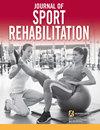Effects of Foam Rolling Prior to Proprioceptive Neuromuscular Facilitation Stretching on Hamstring Flexibility and Thigh Skin Temperature.
IF 1.5
4区 医学
Q3 REHABILITATION
引用次数: 0
Abstract
CONTEXT Proprioceptive neuromuscular facilitation stretching (PNFS) is suggested to improve the range of motion and flexibility as an active warm-up. Recently, the foam rolling (FR) methods have also emerged as a passive warm-up. However, the combined effects of PNFS and FR are still unclear, and no reports have compared their effects using thermal imaging. This study investigated the acute effects of combining nonvibration FR (NVFR) and vibration FR (VFR) prior to PNFS, in comparison with PNFS alone, on hamstring flexibility and thigh skin temperature. DESIGN Randomized controlled trial. METHODS Participants (n = 60) were randomly assigned to PNFS, NVFR + PNFS, VFR + PNFS, and control group (CG). Active knee-extension (AKE), sit and reach (SR) test, and thermal imaging were evaluated before (pre-int), immediately after (post-int), and 30-minutes after (post30-int) intervention. RESULTS All intervention groups had a significant increase at all time periods (P < .001) except the CG in terms of AKE and sit and reach test (P > .05). Combined (NVFR + PNFS/VFR + PNFS) groups had also a significant increase in the post30-int compared with pre-int and post-int values of thigh skin temperature (P < .001). Combined groups, over time, had the best post30-int effect on increasing skin temperature. The study found a significant interaction effect between interventions and time across several measurements (P < .05). Combined groups showed more significant improvements in AKE compared to CG at post-int (P < .05). There is a similar change in AKE, SR test, and skin temperatures between combined groups and PNFS alone at both post-int and post30-int (P < .05). CONCLUSIONS These findings indicate that using FR, with or without vibration, before PNFS does not provide an additional benefit in improving hamstring flexibility and thigh skin temperatures compared with PNFS alone.在进行知觉神经肌肉促进拉伸之前进行泡沫滚揉对腘绳肌柔韧性和大腿皮肤温度的影响
CONTEXTProprioceptive neuromuscular facilitation stretching (PNFS) 被认为是一种主动热身方法,可以改善运动范围和柔韧性。最近,泡沫滚动法(FR)也作为一种被动热身方法出现。然而,PNFS 和 FR 的综合效果尚不明确,也没有报告使用热成像技术比较这两种方法的效果。本研究调查了在进行 PNFS 之前结合非振动 FR(NVFR)和振动 FR(VFR)与单独进行 PNFS 相比,对腿筋柔韧性和大腿皮肤温度的急性影响。分别在干预前(pre-int)、干预后(post-int)和干预后 30 分钟(post-30-int)对膝关节主动伸展(AKE)、坐位和伸展(SR)测试以及热成像进行评估。结果除对照组(CG)的膝关节主动伸展(AKE)和坐位和伸展(SR)测试(P > .05)外,其他干预组在所有时间段均有显著提高(P < .001)。联合组(NVFR + PNFS/VFR + PNFS)在 30 分钟后的大腿皮肤温度值与 30 分钟前和 30 分钟后相比也有明显增加(P < .001)。随着时间的推移,联合组在 30 分钟后提高皮肤温度的效果最好。研究发现,在多项测量中,干预与时间之间存在明显的交互效应(P < .05)。与 CG 相比,联合组在 30 分钟后的 AKE 有更明显的改善(P < .05)。结论:这些研究结果表明,与单纯的 PNFS 相比,在 PNFS 之前使用 FR(无论是否有振动)并不能在改善腿筋柔韧性和大腿皮肤温度方面带来额外的益处。
本文章由计算机程序翻译,如有差异,请以英文原文为准。
求助全文
约1分钟内获得全文
求助全文
来源期刊

Journal of Sport Rehabilitation
医学-康复医学
CiteScore
3.20
自引率
5.90%
发文量
143
审稿时长
>12 weeks
期刊介绍:
The Journal of Sport Rehabilitation (JSR) is your source for the latest peer-reviewed research in the field of sport rehabilitation. All members of the sports-medicine team will benefit from the wealth of important information in each issue. JSR is completely devoted to the rehabilitation of sport and exercise injuries, regardless of the age, gender, sport ability, level of fitness, or health status of the participant.
JSR publishes peer-reviewed original research, systematic reviews/meta-analyses, critically appraised topics (CATs), case studies/series, and technical reports that directly affect the management and rehabilitation of injuries incurred during sport-related activities, irrespective of the individual’s age, gender, sport ability, level of fitness, or health status. The journal is intended to provide an international, multidisciplinary forum to serve the needs of all members of the sports medicine team, including athletic trainers/therapists, sport physical therapists/physiotherapists, sports medicine physicians, and other health care and medical professionals.
 求助内容:
求助内容: 应助结果提醒方式:
应助结果提醒方式:


